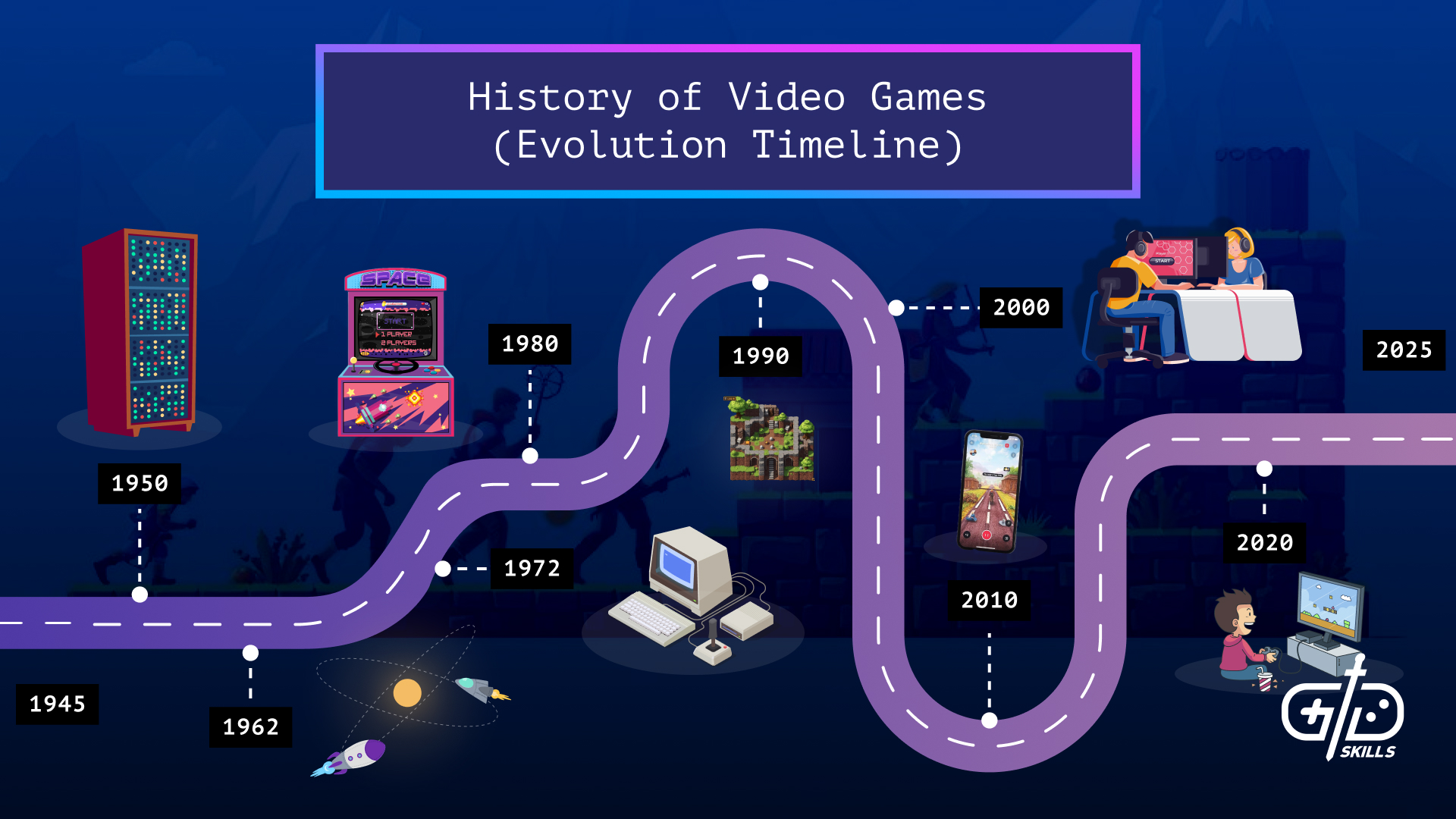A video game is an interaction with images onscreen for entertainment. The history of video games dates back to the invention of the first human-screen interactive game, the Cathode Ray Tube (CRT) Amusement Device in 1948. The CRT Amusement Device never went into production, but it did introduce the novel idea of interacting with images onscreen for fun. Early computer-controlled games that the public experienced were variations on tic-tac-toe or other logic puzzles. Bertie the Brain, created for the Toronto Exhibition in 1950, responded to players’ moves and featured a difficulty slider. Tennis for Two, created at the Brookhaven National Laboratory in 1958, was an early version of Pong, and is considered the first real-time graphical video game made purely for entertainment.
Mainframes and microcomputers at research institutions in the 1960s provided the next platform for programmers to experiment with. The increased power of computers at research institutions like MIT led to the development of the game Spacewar! in 1962. Spacewar! was the first game shared among multiple institutions and influenced many of the first commercially available games in the 1970s. Pong in 1972 was the first commercial success story for coin-operated video games. The same year, Magnavox licensed Ralph Baer’s Brown Box design and released it under the name the Magnavox Odyssey.
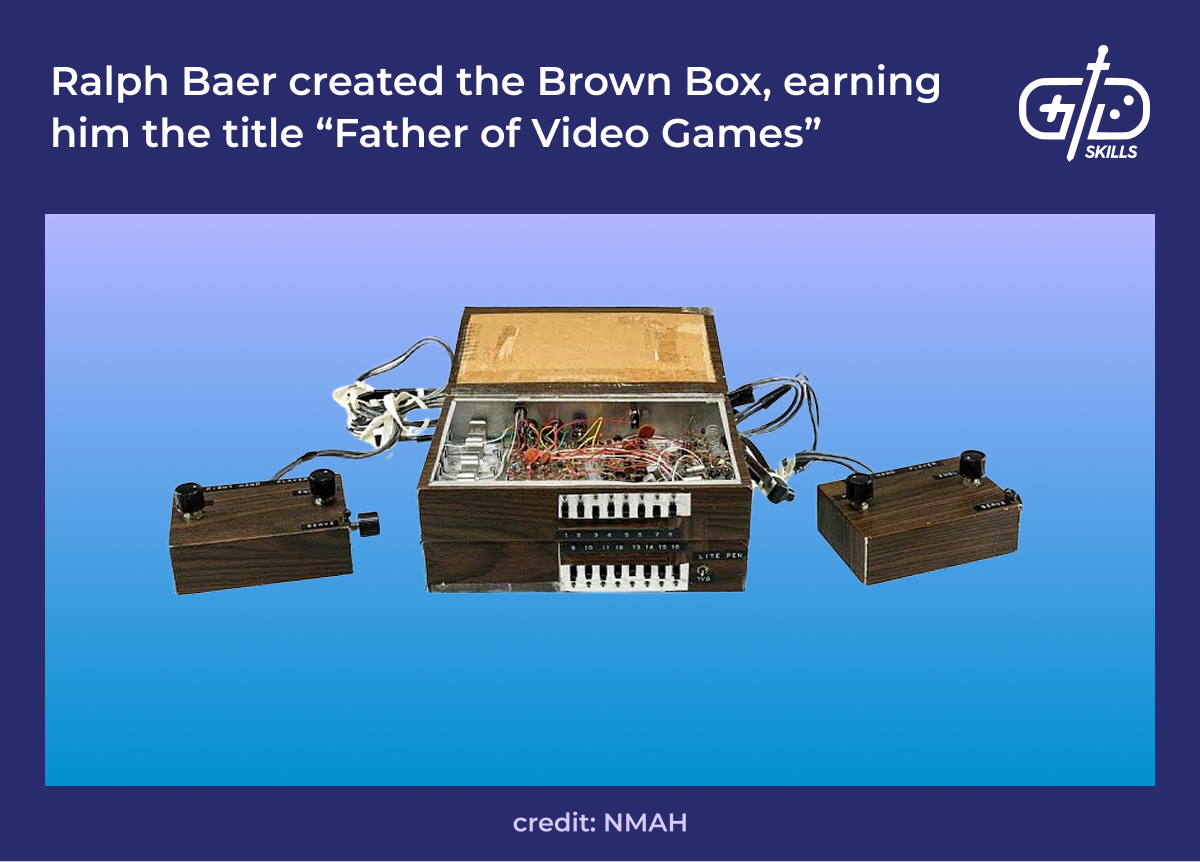
The Magnavox Odyssey was the first multiplayer home console, but Space Invaders in 1977 was the first smash hit for arcades and introduced many people to the concept of a video game. Video game sales on consoles and at arcades experienced a boom from the late 70s until the early 80s. By that time, market over-saturation with too many competing consoles and many inferior games led to a market crash. It would take Nintendo’s step into the hardware market to stabilize the nascent industry and create the foundations for today’s gaming landscape. Read on to learn about the experiments, false starts, and momentous successes that created the medium we love.
1948 – Thomas T. Goldsmith Jr. and Estle R. Mann patented the “Cathode-Ray Tube Amusement Device”
The Cathode-Ray Tube Amusement Device was an analog electronic game that used a cathode-ray tube (CRT) to display and control a dot onscreen. Using knobs, players controlled the trajectory of dots (representing missiles), aiming to hit paper targets (representing planes) that were manually placed on the screen. The CRT Amusement Device relied entirely on analog circuitry to control the electron beam and, unlike modern video game systems, contained no digital computer. Thomas T. Goldsmith Jr. and Estle R. Mann patented the CRT Amusement Device in 1948, more than two decades before the first commercially available video game system, the Magnavox Odyssey.

The CRT Amusement Device never went into production or became available to the public, but its development is significant, nonetheless. Manipulating an electron beam to create interactive visuals was a seminal contribution from Goldsmith and Mann, one used in arcade machines, home consoles, and a stepping stone to modern video gaming. The CRT Amusement Device was never widely shown, however, and its patent wasn’t rediscovered until 2002 when a French electronics collector discovered the documents as part of a file for a 1974 lawsuit by Magnavox against several arcade game companies. The CRT Amusement Device didn’t have much direct influence on the video games industry, but it is an interesting early experiment with manipulating images onscreen for recreation.
1950s – Early experiments and prototypes
The 1950s saw the rise of the first interactive computer game experiences available to the public. Josef Kates created Bertie the Brain for the Toronto Exhibition in 1950. Bertie was a four-meter-tall computer that played Tic-Tac-Toe against human opponents who interacted directly with a light-up display. Bertie the Brain is considered the first game where players could compete against a computer. Bertie’s adjustable difficulty level was a notable feature for an early prototype. Nimrod was a computer created to play the mathematical strategy game Nim by Feranti Ltd. for the 1951 Festival of Britain. Players input commands on a light panel display, and the computer responds.
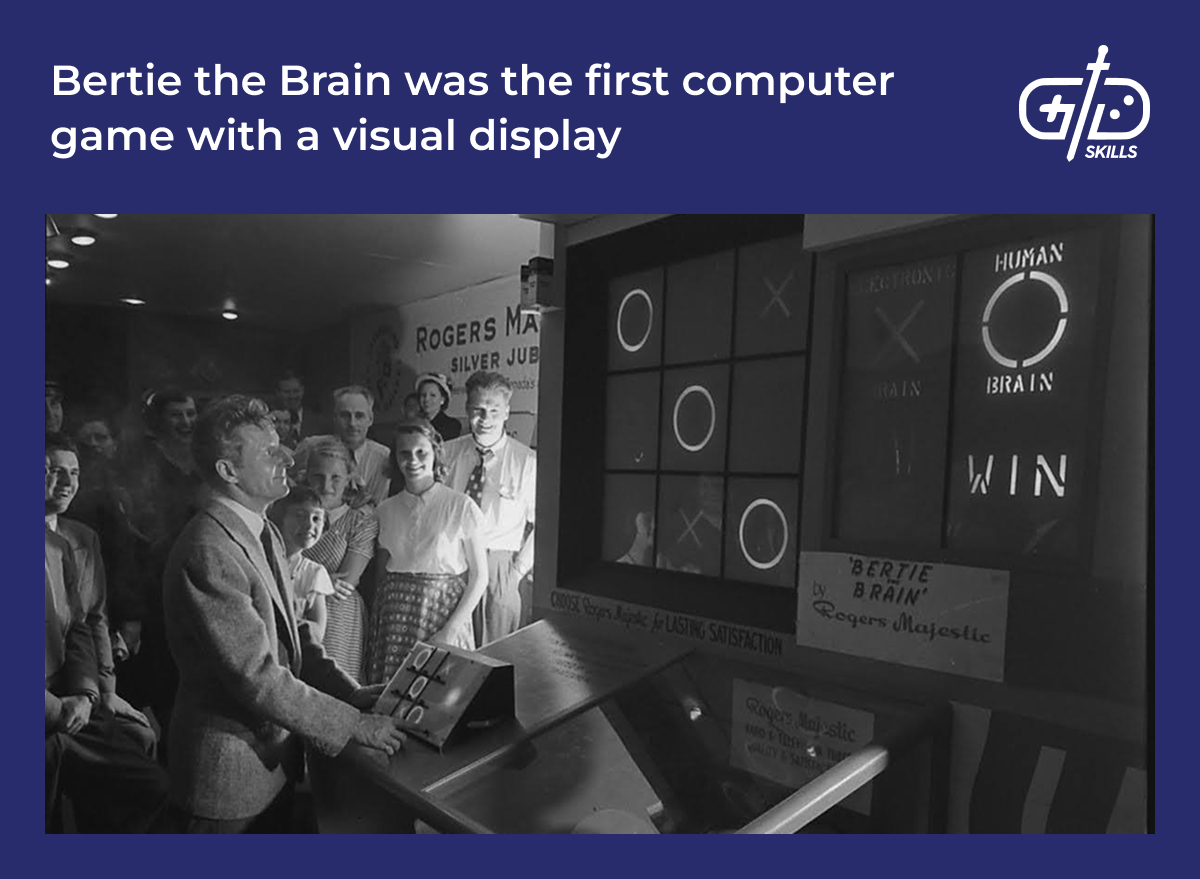
OXO, an electronic version of tic-tac-toe, was created by A.S. Douglas for his doctoral dissertation at the University of Cambridge. OXO used a CRT display to show gameplay and took input from a rotary dial. Douglas’s dissertation was on human-computer interaction, and his use of gameplay visualized on a CRT and input from a controller means OXO is referred to as the first video game (there’s competition for this title). William Higinbotham created Tennis for Two in 1958 at the Brookhaven National Laboratory using an oscilloscope display connected to an analog computer to simulate two-player tennis. Players controlled paddles on either side of the screen using custom controllers with a button and knob combo. The knob controlled the angle of the shot and the button was used to hit the ball. Tennis for Two is considered the first real-time video game with graphics made purely for entertainment. Its concept, control, and ball physics were influential on the first commercially successful video game, Pong.
1960s – Computer scientists create games on larger computers
Technology in the 1960s allowed scientists at research institutions like the Massachusetts Institute of Technology (MIT) to develop video games on mainframes and microcomputers. The larger computers and subsequent computing power created games like Spacewar! in 1962, which is considered (by some) the first interactive video game with real-time graphics in history. Steve Russell and his fellow students at MIT created Spacewar! on a DEC PDP-1 (Digital Equipment Corporation’s Programmed Data Processor-1) machine at the MIT academic center. Spacewar! featured two ships (The Needle and The Wedge) locked in a dogfight around a star with simulated gravity affecting flight. The game was shared across many early computer installations in American academic institutions, making Spacewar! the first game to be played outside a single research institute. Its influence on programmers of early computer games was immense, as demonstrated by the similarities to Spacewar! in the first commercially available video game, Computer Space.
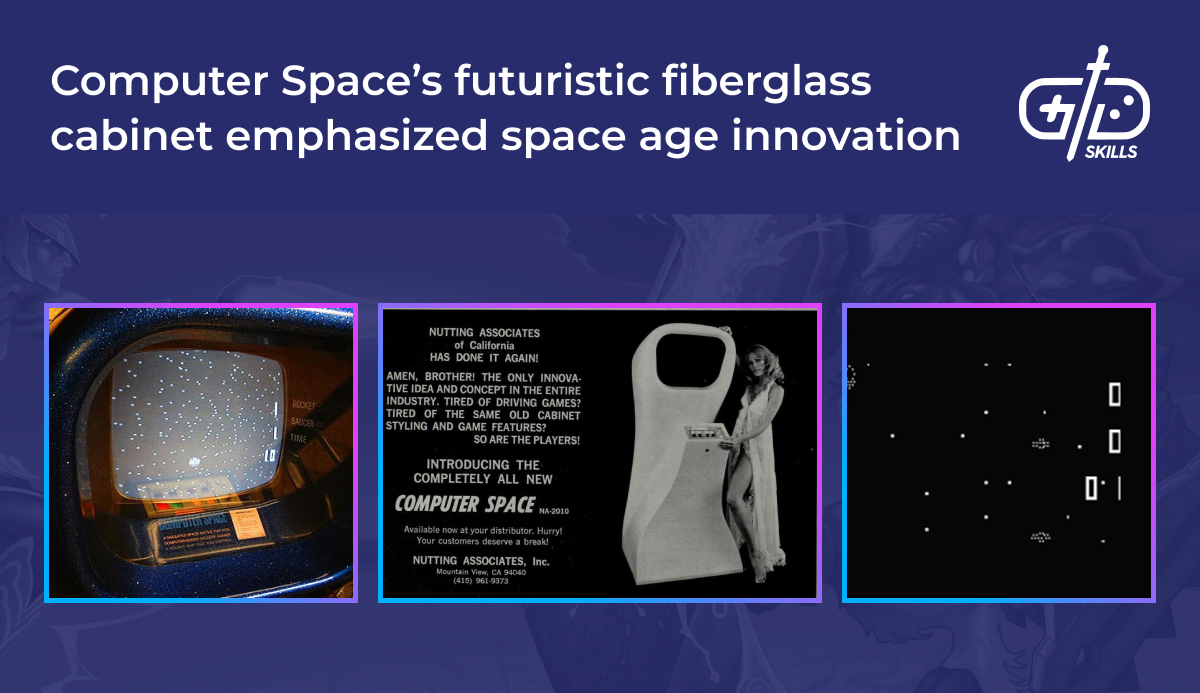
The Brown Box was a prototype video game console that Ralph Baer and his team developed between 1966 and 1968. The Brown Box used analog circuitry to control game logic and video signals. Swappable game cards altered the game by changing the system’s logic circuits. The Brown Box is notable for being the first multiplayer, multi-program home video game system, despite never going into full-scale production as the Brown Box. The system’s name comes from the woodgrain panelling that covered the original prototype. Games on the Brown Box included Ping-Pong (a precursor to Pong), Checkers, Target shooting (with a light gun), and Maze games. The original Brown Box is now housed in the Smithsonian Museum. Its creator, Ralph Baer, is referred to as the father of video games due to his work on the Brown Box.
1970s – Birth of the commercial video game industry
The first commercially available arcade video game was Computer Space, a space combat game created by Nolan Bushnell and Ted Dabney, and heavily inspired by Spacewar! Computer Space was released by Bushnell and Dabney under the company name Syzygy Engineering in 1971 and sold somewhere between 1300 and 1500 units. It wasn’t a failure, but neither was it a runaway success. Bushnell and Dabney later incorporated Syzygy as Atari. Programmer Allan Alcorn created Pong as a training exercise set by Atari co-founder Nolan Bushnell. Surprised by the quality of Alcorn’s results, Atari released Pong in November 1972. The game was the first commercially successful arcade video game. Pong was clearly inspired by the electronic ping pong game included on the Brown Box.
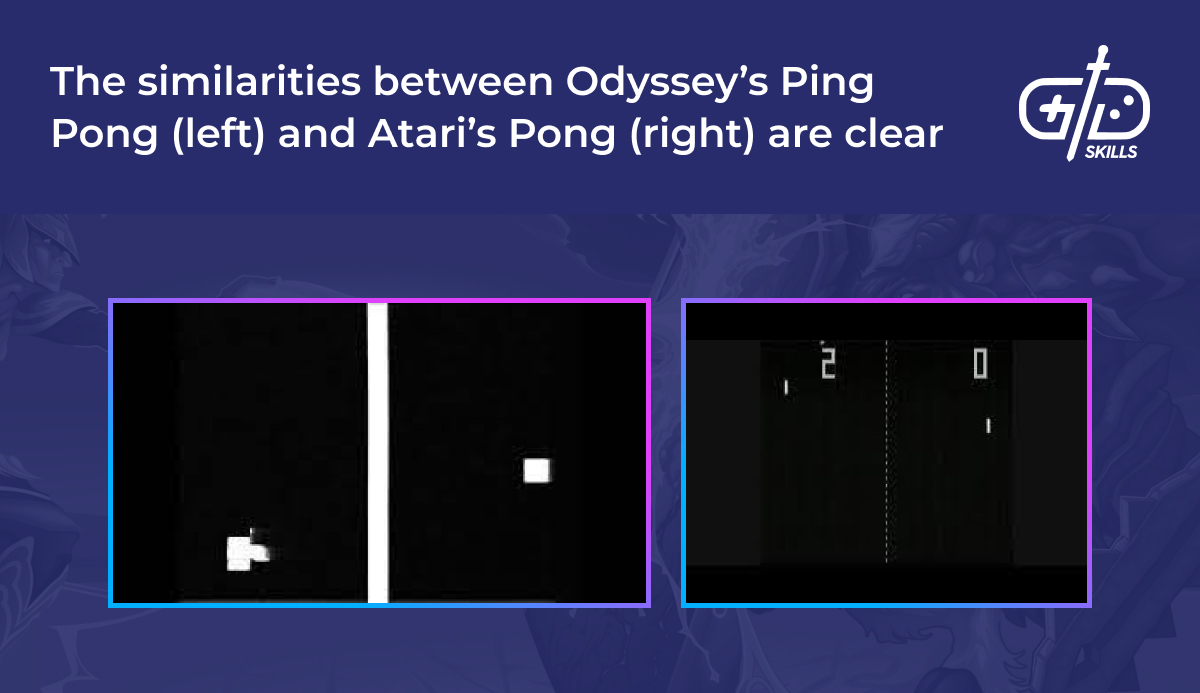
In 1972, Magnavox licensed the Brown Box, releasing it under the name the Magnavox Odyssey in September of that year. The Odyssey predates the release of Atari’s Pong by several months and is the first home game console ever sold. Atari’s Pong was so similar to the Odyssey’s ping pong that Magnavox sued Atari for patent infringement. ROM-based cartridges in the mid-1970s increased the versatility and appeal of home consoles by offering different games as external media. Before ROM cartridges, consoles played a set number of games (usually variations on Pong) by changing the system’s logic signals. (The Magnavox Odyssey featured swappable games, but the variety was limited.) If you wanted new games, you needed a new system. ROM-based cartridges were introduced with the Atari VCS (later branded the Atari 2600) in 1977. Each cartridge typically held between 2 and 4 KB of data, and their introduction meant players could expand their library of games indefinitely. Cartridges also allowed for the founding of third-party developers, the first of which was Activision in 1979, comprising former Atari employees.
The golden age of arcade games began in the late 1970s with breakthrough hits like Space Invaders in 1978. Space Invaders was a fixed shooter with music that responded to the action on screen. Inspired by arcade titles like Gun Fight and Breakout, Space Invaders was the first game to popularize the idea of playing for a high score. When Space Invaders was ported to the Atari VCS system, it quadrupled the console’s sales, becoming the first killer app for a gaming system. Space Invaders broke through the market in a way no game had before it, creating a cultural phenomenon and inspiring many similar games. (Proximity to late 70s Hollywood sci-fi classics like Star Wars, Alien, and Close Encounters of the Third Kind likely contributed to the popularity of sci-fi shooters.) Shooters Galaxian and Asteroids from 1979 enjoyed similar success to Space Invaders. Frogger, Defender, Galaga, Pac-Man, and Pole Position followed, creating queues in arcades, brand names, and genres recognized today.
1980s – Highs and lows for the video game industry
An arcade industry boom followed the success of classics like Space Invaders, Galaga, Pac-Man, and Donkey Kong. Dedicated video game arcades began to appear, where video games had previously been one of several coin-operated entertainment options or a distraction at pizza parlors or laundromats. The golden age of arcade machines ran from 1978 to 1982. This period saw the rapid development of technology and the emergence of nascent genres like shooter, platformer, racing game, and fighting games. Named characters began to appear during this time, with Pac-Man, Q*bert, and Donkey Kong leading the way. Some of the popular characters from this period transitioned over to other media like comic books, cartoons, and novelty songs.
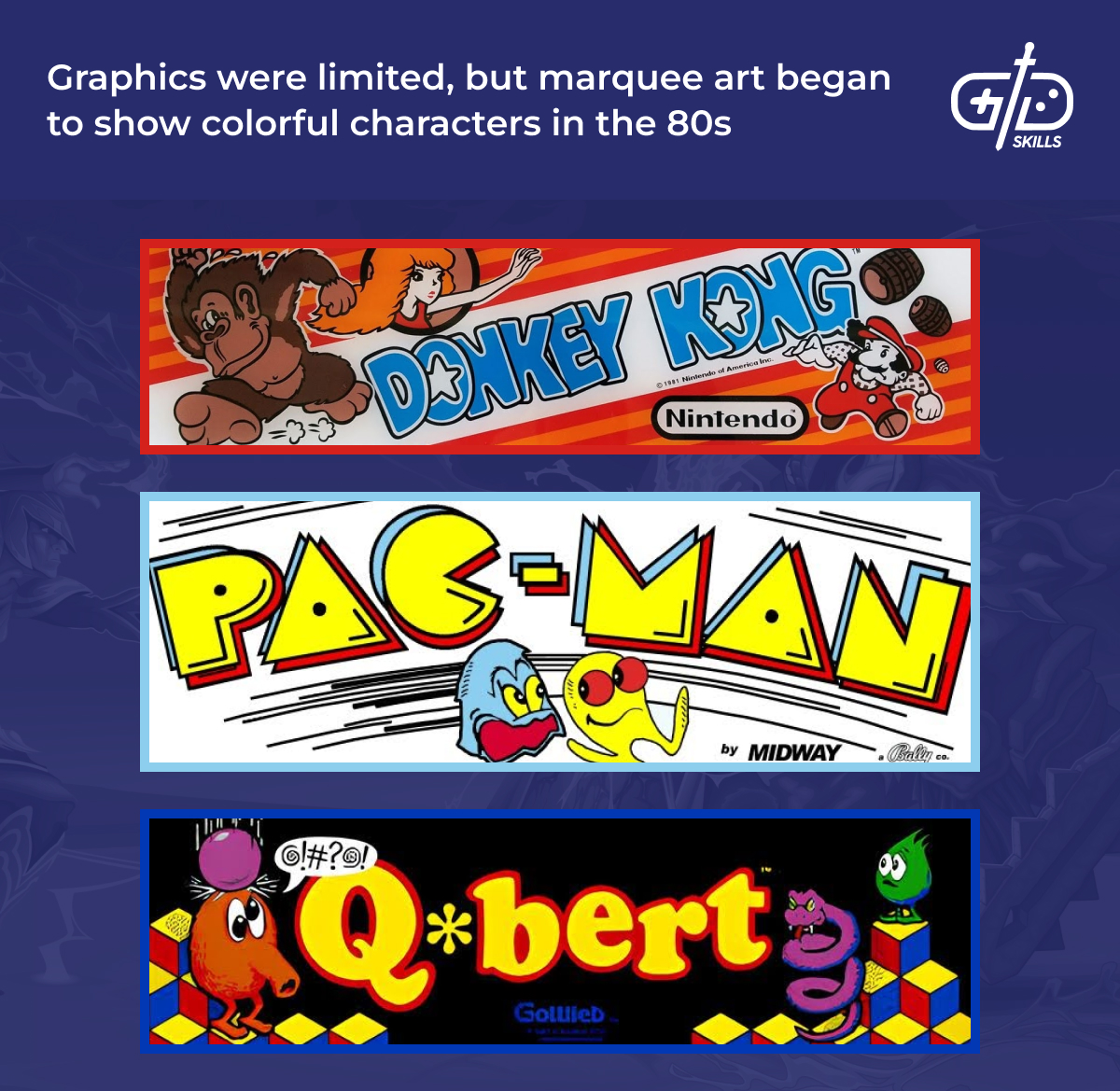
The popularity of arcade games led to a wave of clones that saturated arcades with inferior experiences, damaging revenue at coin-operated businesses. A moral panic around the influence of arcades and video games on children was another factor that damaged the reputation of video games. The rapid expansion of the home console market led to competing systems being released by Atari, Odyssey, Intellivision, ColecoVision, and Vectrex. Each system had its own library of exclusive games, the quality of which was inconsistent at best. The rise of third-party publishers meant console manufacturers couldn’t directly oversee the quality of all software released on their platform. Saturation, over-projected demand for consoles, and the introduction of affordable, versatile home computers (that could also play games) led to a market crash. From 1983 to 1985, the video game industry experienced a large-scale recession.
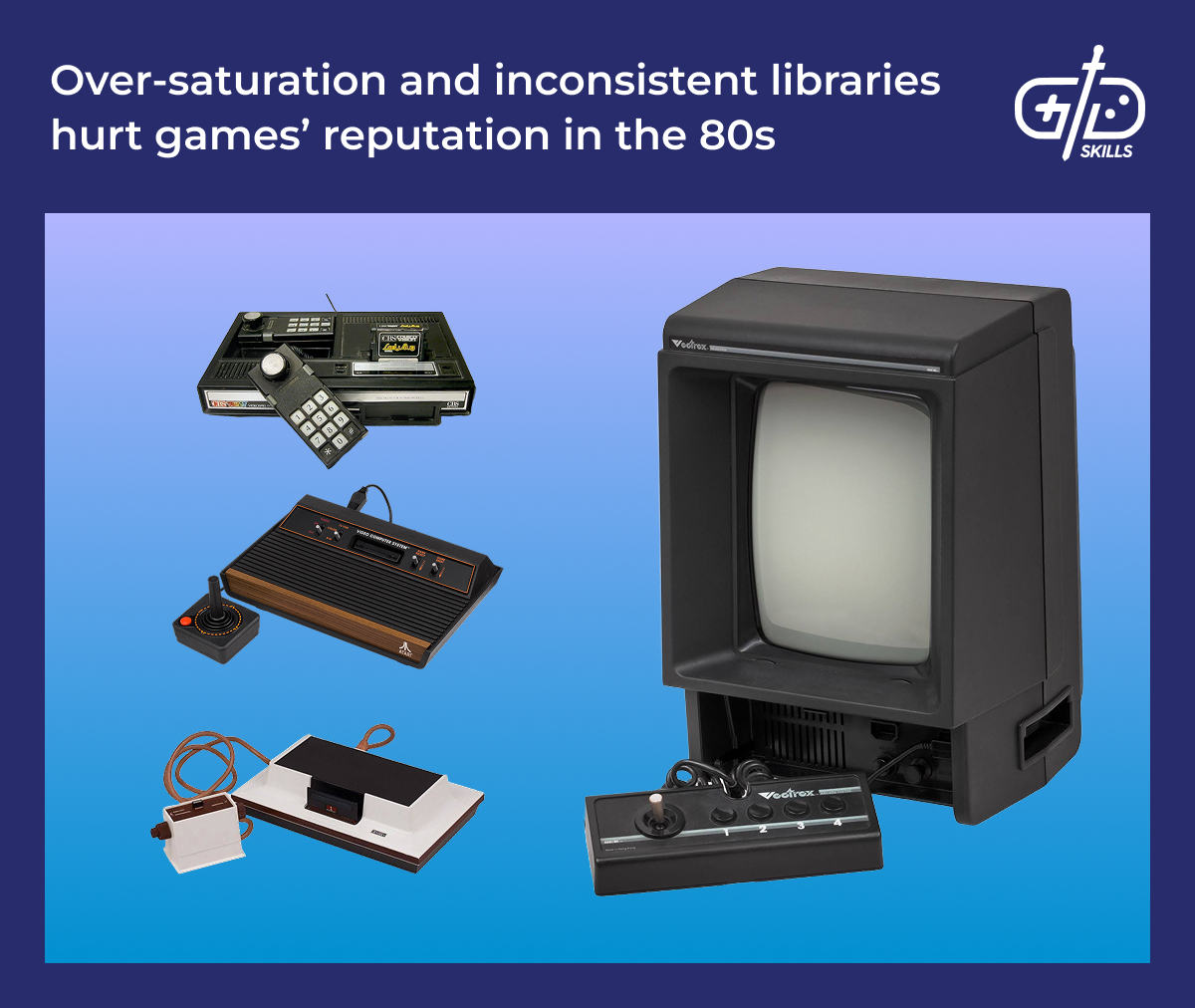
1985 saw Nintendo enter the home console market with the Nintendo Entertainment System (NES). Aware of the lack of consumer confidence, Nintendo’s branding avoided any use of the term video game, instead dubbing itself an entertainment system. Nintendo also used a seal of quality system, only allowing games that met their criteria to release on the platform. Super Mario Bros in 1985 redefined the side-scrolling platformer, drawing from the Famicom team’s three years of experience in game mechanics and programming working on games like Excite Bike, Devil World, and Kung Fu. The Legend of Zelda (1986) combined elements from action-adventure and role-playing games that captured players’ imaginations at the time and spawned a franchise that’s still a worldwide bestseller today. Metroid and Castlevania expanded the scope and complexity of action games while Mega Man set the bar for side-scrolling shooters in the 8-bit generation of consoles. The Nintendo Entertainment System’s innovation in marketing and quality control led to a market recovery as consumer confidence in gaming returned.
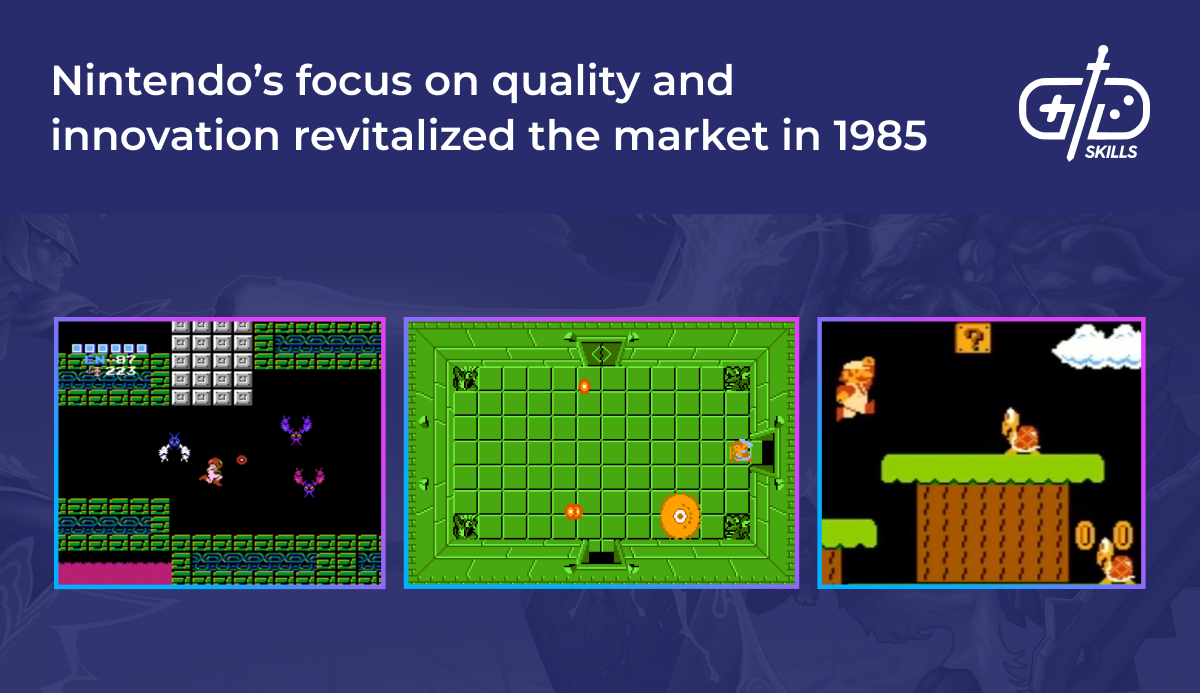
Sega had moderate success in Japan and Europe during the 8-bit generation with their Master System, but limited success in North America. To respond to Nintendo’s dominance, Sega released the Genesis (the Mega Drive outside North America) in Japan in 1988 and the USA in 1989. The Genesis was designed to bring arcade-quality games into the home by leveraging Sega’s experience in the arcade market and making use of a 16-bit CPU. Sega ran with the marketing line, Genesis does what Nintendon’t, to play up the differences in power. Altered Beast was an early example of how the Genesis could output arcade-quality visuals in a way the NES couldn’t. The TurboGrafx-16 (known as the PC Engine in Japan) was released to the Japanese market in 1987 and in North America in 1989. It achieved success in Japan, but struggled to compete with the NES and the rising Genesis in North America. The “16” in the Turbo-Grafx-16’s title was sometimes criticized as misleading, as the machine featured an 8-bit CPU paired with two 16-bit GPUs.
1990s – Innovation, particularly in graphics
The 1990s saw innovations in hardware, graphics, and gameplay, with the transfer from 2D to 3D in the mid 90s being the most significant change. The early 90s were dominated by the Super Nintendo (SNES) and Sega Genesis, platforms ideal for handling the 2D games the 16-bit era is remembered for. Players are still nostalgic for 16-bit 90s games like Chrono Trigger, Mario Kart, Street Fighter II, Sonic the Hedgehog, and Shinobi III. Graphics from this era are considered the pinnacle of 2D sprite and pixel work. The Genesis and SNES used parallax scrolling, scaling, and rotating sprites to create depth and motion. The SNES featured a 2D graphics technique called Mode 7 that simulated 3D by rotating and scaling background layers. Mode 7 is featured in games like F-Zero and Super Mario Kart. The mid-90s were also the time when true 3D graphics first started to appear. Doom in 1993 ushered in the FPS revolution with its Doom 3D engine, featuring texture mapping, raycasting, and 2.5D rendering to simulate 3D. Windows 3.1’s graphical interface made installing and playing games on PC easier than it had ever been, and the mid-90s saw a boom in PC gaming.
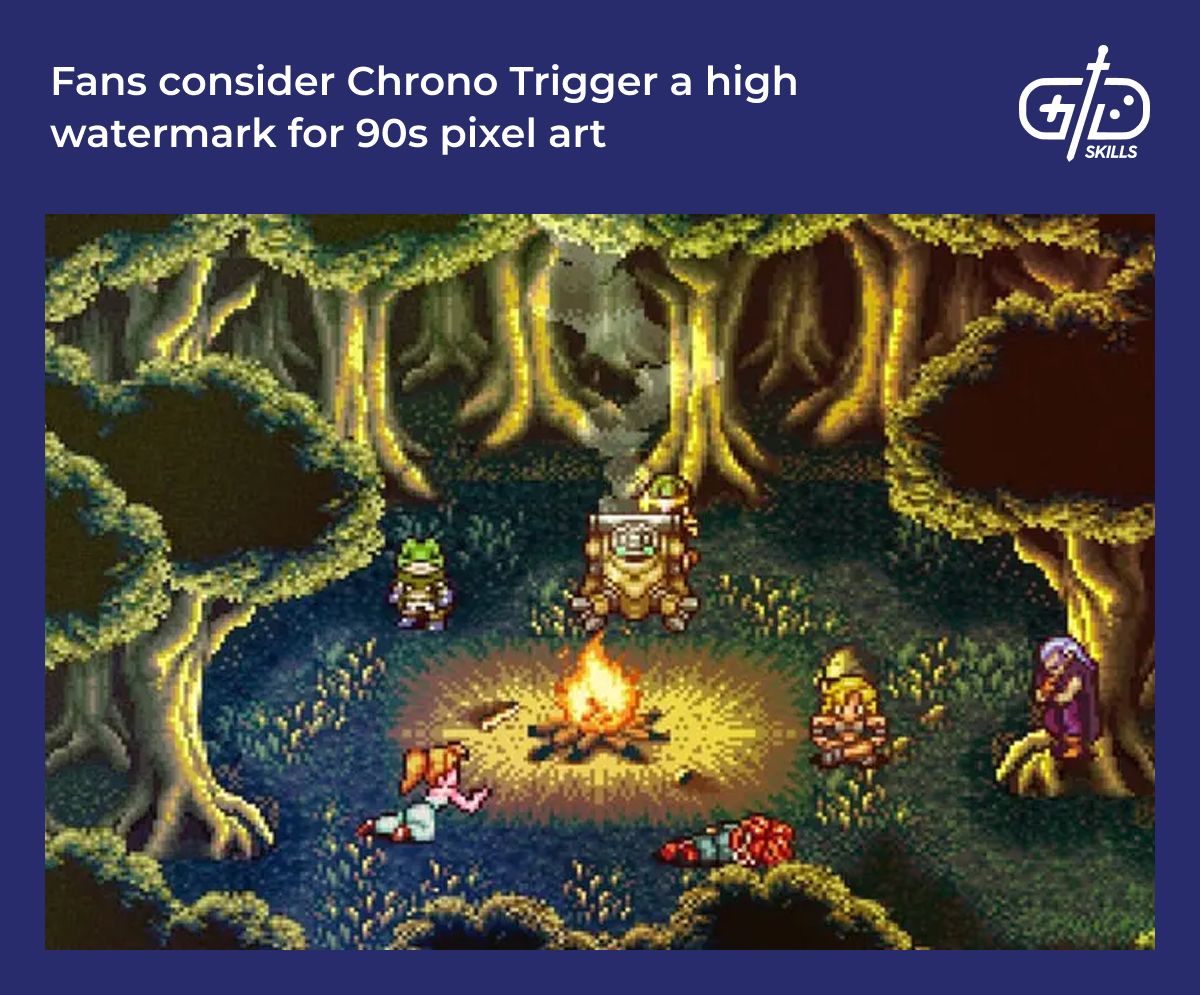
Quake’s polygon rendering, 3D acceleration, and dynamic lighting in 1996 set a new bar for FPS gaming. VESA standards and SVGA cards from companies like 3Dfx, Matrox, and S3 Graphics pushed the limits of 3D acceleration on the PC. At a similar time, consoles from Sony, Nintendo, and Sega released hardware that could output true 3D graphics at home. The Sony PlayStation featured true 3D real-time rendering in games like Wipeout 2097, and detailed prerendered backgrounds with 3D sprites in games like Final Fantasy VII. Final Fantasy VII’s CG cutscenes brought new levels of cinematic drama to the medium. The Nintendo 64 redefined 3D platforming and camera controls with Mario 64, and had the multiplayer console FPS game of the generation in Goldeneye 007.

Sega’s Saturn console failed to capture as large a section of the audience as PlayStation and Nintendo, but the platform is remembered for 3D games like Sega Rally Championship and 2D bullet hell shooters like Radiant Silvergun. Sega’s Dreamcast in 1998 had excellent 3D visuals, a solid library, and early Internet capabilities, but failed to capture enough of the market to remain viable. In the late 1990s, 3Dfx Voodoo graphics cards and the rise of Unreal Engine saw PC graphics develop rapidly. Voodoo cards (and their competitors) could push the shader technology and dynamic lighting using hardware acceleration, creating new levels of scale and detail in 3D environments in games like Unreal and Unreal Tournament. These developments allowed game spaces to develop in scope and detail, paving the way for a new generation of 3D gaming on console and PC.
2000s – The age of the Internet and new consoles
The 2000s marked the beginning of the true age of Internet gaming and the launch of the 6th generation of consoles. PCs had embraced Internet connectivity in the years before the millennium, and consoles like the Sega Saturn, Dreamcast, and SNES Satellaview (Japan only) had limited online functionality. Console and PC games post-2000 began to offer online multiplayer modes as standard. Halo: Combat Evolved, from 2001, was an Xbox launch title that predates the release of the Xbox Live service, and consequently, only supported LAN multiplayer. 2000s kids remember Halo LAN parties with multiple Xboxes networked—memories that primed players for Halo’s sequel, Halo 2.

Halo 2 set the gold standard for online multiplayer shooters with its high production values, slick multiplayer gameplay, and effective matchmaking system. Counter-Strike from Valve in 2000 took advantage of the possibilities afforded by the new levels of Internet bandwidth, pitting groups of PC players against each other as terrorists and counter-terrorists in objective-based matches. World of Warcraft in 2004 wasn’t the first MMORPG, but it set the bar for immersion, storytelling, worldbuilding, community, and long-term character building in a persistent universe.
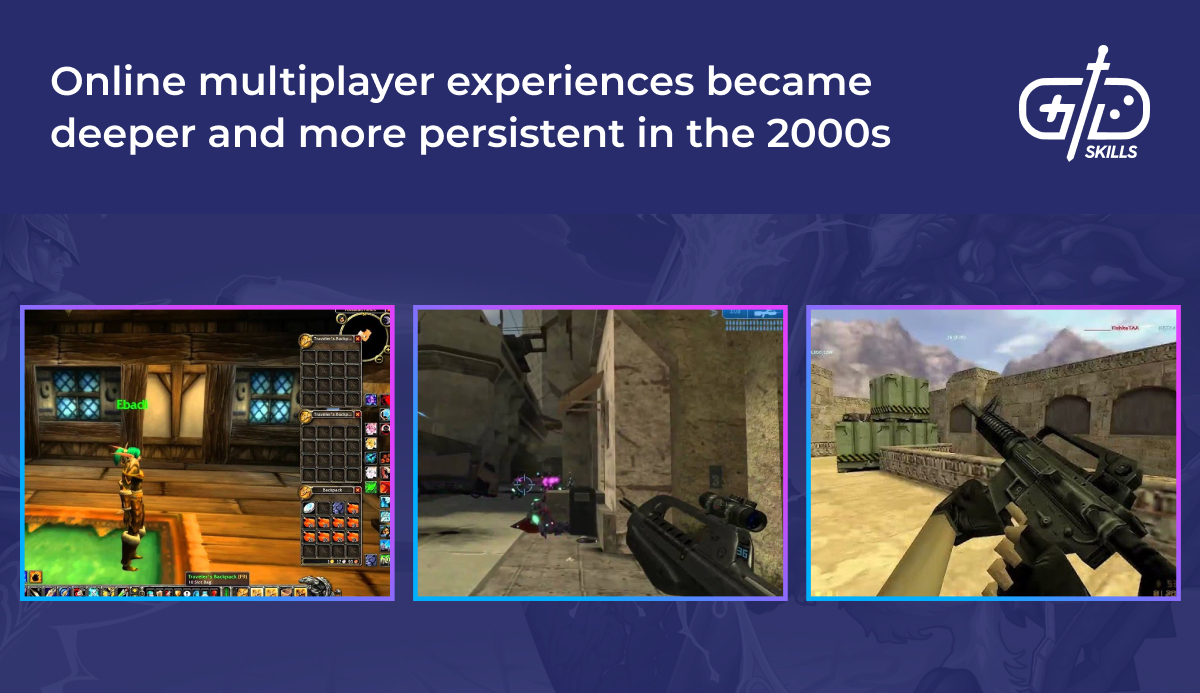
The sixth generation of consoles technically began with the release of the Dreamcast in 1998, but it was the PlayStation 2, released on March 4, 2000, that dominated the generation and went on to become the best-selling console in history. Nintendo’s GameCube and Microsoft’s Xbox launched a year later in 2001. The sixth generation saw a marked jump in visual fidelity with better textures, lighting, and models. The PS2 launched without built-in online functionality, releasing a network adapter that plugged into the unit’s expansion bay a year later. The Xbox released with built-in network capabilities, but its Live service didn’t come online until a year post-launch. Both systems doubled as DVD players, but the PS2 worked without a “playback kit”. This fact, and the PS2’s large library and healthy second-hand market, helped the PS2 dominate. The GameCube supported only eight games online or in networked mode and didn’t play any media other than GameCube discs. As always, Nintendo produced a strong line-up of first-party titles for their console. Standout games from this generation include Grand Theft Auto III, The Elder Scrolls: Morrowind, Super Smash Bros. Melee, and Shadow of the Colossus.
Distribution, communications, and gameplay began to move online during the 2000s. The widespread adoption of broadband allowed for larger, faster downloads. On PC, Steam launched in 2003, initially to sell and update Valve’s products, then later featuring games from third-party developers. Steam introduced concepts like cloud saves, achievements, and auto-updates. The Xbox Live service launched in 2002 as a subscription service one year after the console’s launch, enabling online multiplayer, voice chat, friend lists, and matchmaking, most notably with its killer app, Halo 2. The PS2 online service launched in North America in late 2002, with SOCOM U.S. Navy SEALs, Twisted Metal: Black Online, NFL GameDay 2003, and FreQuency Online, Sega’s NFL 2K3, EA Sports’s Madden NFL 2003, and Activision’s Tony Hawk’s Pro Skater 3 as the launch titles. Despite vibrant communities and many supported games, online console platforms wouldn’t begin to distribute digitally until the next generation of consoles.

The mid-2000s saw the launch of the seventh generation of consoles. Sega dropped out of the hardware race, leaving the Xbox 360, PlayStation 3, and Nintendo Wii to fight for market dominance. The seventh generation marked the beginning of online distribution and marketplaces for consoles. The Xbox Live Marketplace launched with the new Xbox 360 in 2005, offering demos, DLC, updates, and a digital storefront. The PlayStation Store followed in 2006 with the launch of the PlayStation 3, offering a marketplace, DLC, demos, and updates. The Wii Shop Channel launched with Nintendo’s Wii, offering exclusive games (called WiiWare) and games from previous Nintendo generations through the Virtual Console channel. Handhelds in the mid-2000s offered high-fidelity 3D experiences with Sony’s PSP and unique control and gameplay options with the Nintendo DS. The PSP’s multimedia capabilities were an attractive option for commuters and long-distance travellers, while the DS’s killer first-party game library and family-friendly charm made it a hit with all ages.
2010s – Mobile gaming, indies, and esports
The launch of the iPhone in 2007 and the App Store in 2008 had set the stage for mobile gaming, but the 2010s saw the mass adoption of smartphones globally. Successful mobile games were designed with innovative touchscreen controls, short play sessions, and social integration in mind. Games like Angry Birds in 2010, Candy Crush Saga in 2012, and Clash of Clans in 2012 reached global audiences with their casual gameplay appealing to non-traditional gaming demographics. These games (and many other mobile titles) used the free-to-play (F2P) model, where the game has no upfront cost, but offers in-app purchases. Pokémon Go! in 2016 was the first popular location-based AR title, becoming a global phenomenon and opening the door for more AR titles. Graphical fidelity and performance on mobile had improved by the late 2010s, and games like PUBG Mobile and Call of Duty Mobile brought high-production-value FPS games to the format.
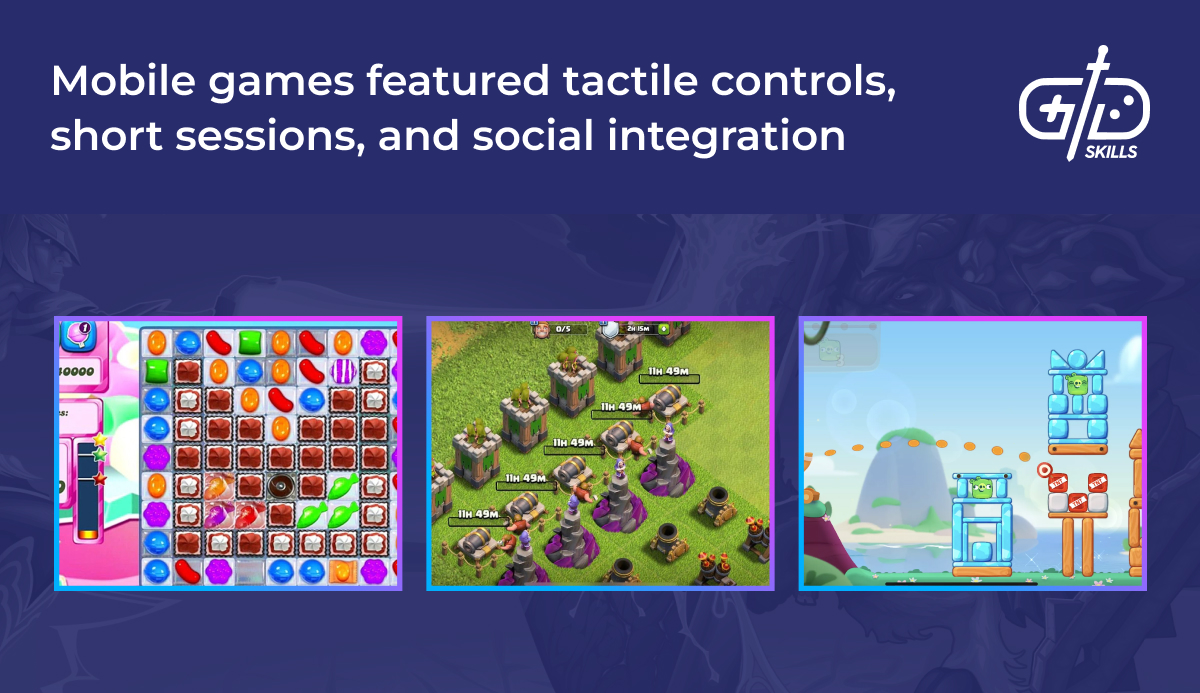
In the 2010s, the widespread use of platforms like Steam, Itch.io, Xbox Live Arcade, PlayStation Network, and later Nintendo eShop allowed indie devs to self-publish. Global audiences could access, rate, and recommend games from devs of all levels. Game engines like Unity and Unreal Engine 4 were more accessible than previous engines, levelling the playing field and allowing indie devs to create experiences without large teams or funding. Indie games from this period focused on emotional storytelling, innovative gameplay, and off-kilter mechanics. Games like Braid from 2008, Limbo from 2010, and Fez from 2012 are typical examples of this first wave of successful indie games. Undertale from 2015 told a subversive and deep story with primitive visuals, while Stardew Valley kickstarted the cozy game revolution. When the 8th generation of consoles (Wii U, PlayStation 4, and Xbox One) launched, indie games and console storefronts were an established part of gaming.

The 2010s were the era of gaming as a spectator sport in what’s now referred to as esports. Contestable multiplayer online battle arena (MOBA) games like Defence of the Ancients (Dota) in 2003 and League of Legends (LoL) in 2009 made for exciting viewing for anyone familiar with their game mechanics. Dota 2’s contests were watched by millions of fans and offered prize money in the tens of millions. In 2016, the LoL tournament’s attendance and online viewer numbers were higher than the NBA, the World Series, and the Stanley Cup. Starcraft 2 was the most-watched game on livestreaming platforms briefly after its 2010 release and remains popular. Counter-Strike: Global Offensive (CS: GO) and Overwatch developed their own first-person shooter esports scene, helped by the rise of streaming platforms like Twitch in 2011 and YouTube Gaming in 2015. In the latter half of the decade, games like Fortnite Battle Royale and PUBG: Battlegrounds popularized the last-man-standing battle royale format.
2020s – Current state of the video games industry
The video game industry saw a boom in the early 2020s as the global COVID-19 lockdowns meant more people turned to gaming for entertainment and social interaction. Animal Crossing: New Horizons, Among Us, and Call of Duty: Warzone saw huge numbers of players. At the same time, supply chain issues caused console shortages during this peak demand. When the new generation of consoles was released in late 2020, many consumers couldn’t get one without overpaying on the secondary market. The new generation of home consoles brought new subscription models with them. Xbox Game Pass led the way, offering a huge library of games for a monthly fee. PlayStation Plus responded by improving its subscription service and adding more titles to its library.
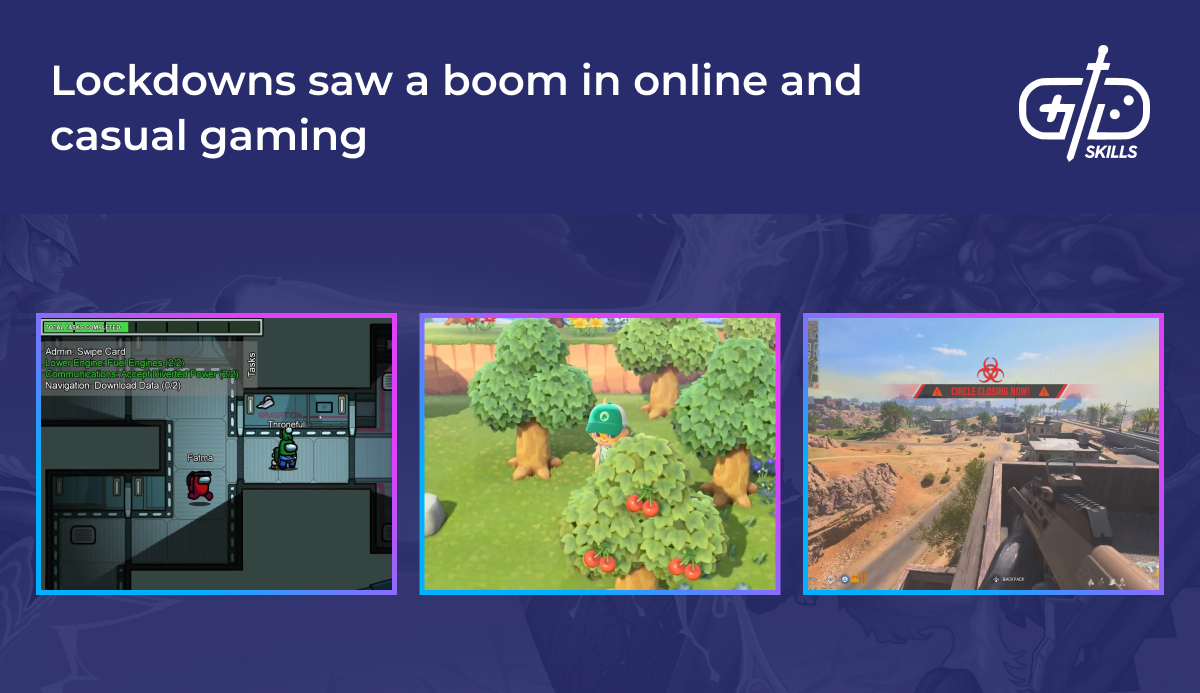
The 2020s marked the rise of cross-platform play and games as ecosystems instead of isolated products. Games like Fortnite, Call of Duty, Minecraft, and Rocket League became too popular for any one platform to want to miss out, leading to widespread crossplay across PC and consoles. New games emerged like Destiny 2 and Halo Infinite that blended single-player action with their online multiplayer seamlessly. The games-as-a-service (GaaS) model offered regular updates, in-game events, and seasonal content, encouraging players to stick with a single game as their hobby. The success of a few games led to a gold rush for live service-type products that resulted in many notable failures. Live service games like Suicide Squad: Kill the Justice League and Concord failed despite large budgets and much hype.
Mobile games continued to represent the largest market share of gaming by revenue through the 2020s. High-quality mobile experiences like Genshin Impact and Honkai: Star Rail offer visuals and gameplay comparable to consoles and generate large profits through their “gacha” random reward system. At the same time, platforms that allow for user-generated content (UGC), like Roblox, Dreams, and Fortnite Creative, encouraged players to build and share their own gameplay experiences inside their game engines. The 2020s saw significant restructuring, acquisitions, and uncertainty after the COVID-19 lockdown boom. Microsoft bought Blizzard and Bethesda, while Sony and Embacer Group also made major acquisitions. 2023 to 2024 saw record revenue for the game industry, but there were many rounds of layoffs nonetheless.
What time period is considered the rise of video games?
The late 1970s are widely considered the time when video games first rose to prominence. Pong from 1972 was the first commercially successful video game, but Space Invaders from 1977 broke through into the mainstream consciousness and made the concept of a video game commonly known throughout the world. The rise of video games comes in peaks and troughs. The late 70s were a boom as people cashed in on the popularity of Space Invaders.
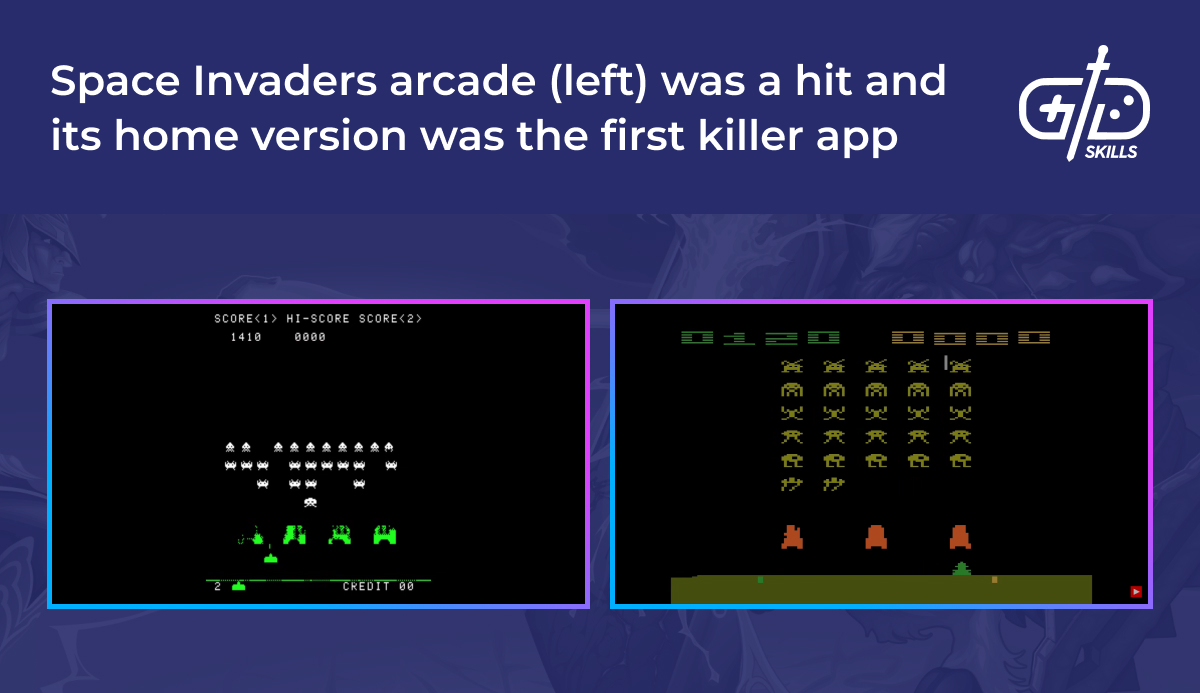
The late 1970s boom led to over-saturation, lower quality control, and consequently, another dip. Nintendo’s entry into the console market in the mid-80s saw another rise in the popularity of video games that never really dissipated. The rise of video games as bona fide “grown-up” entertainment traces back to the 70s and 80s, but takes off in the 90s. Sega’s Genesis marketed itself as a grown-up console in opposition to Nintendo’s family-friendly presentation. PC gaming always had gaming products with grown-up concepts and gameplay, but the PlayStation’s library, advertising, and presentation led to a rise in gaming among young adults that has remained a part of the culture since.
What is considered the golden age of video games?
The golden age of the fighting game is considered to be the 90s, likewise for the JRPG, 2D platform game, and light gun shooter. The golden age of the CRPG is either the late 90s or right now, depending on who you ask. That’s the thing—determining the golden age of video games depends on the demographic you’re asking. Memories of life circumstances color an individual’s conception of the golden age of any medium. (Ask someone over 40 if they prefer music now or music from 20 years ago.) For example, many MMORPG players lament how much better old-school Runescape or original WoW was, compared to modern experiences. In truth, these players don’t miss the old game as much as they miss the old circumstances of their lives. Maybe they miss when all their friends were always online, or they had fewer responsibilities, or life just seemed simpler? Fun is fun. There’s always a golden age happening right now. Nostalgia is a trap.
What are fun facts about video games?
Video games are a relatively new medium. Because the industry is still developing, video games produce some surprising stories. Here are some fun facts about games.
- Kirby, the beloved pink Nintendo mascot, is named after lawyer John Kirby, who defended Nintendo of America in their case against Universal City Studios Inc. in 1983.
- Pong has no source code and is entirely implemented as hardware—no software!
- Donkey Kong was intended to be a Popeye game, but Nintendo couldn’t secure the rights.
- Big Rigs: Over The Road Racing is considered one of the most unfinished games ever released. The devs didn’t set a max reverse speed, and your truck accelerates exponentially until you travel fast enough to cross the known universe in under a millisecond.
- GTA V is the most financially successful entertainment product in history, having earned $7.7 billion.
- More than one-third of the global population regularly plays video games.
- A Game Boy damaged in a tent fire during the Gulf War continued to work despite the blistered case, eventually going on display at the Nintendo Store in New York.
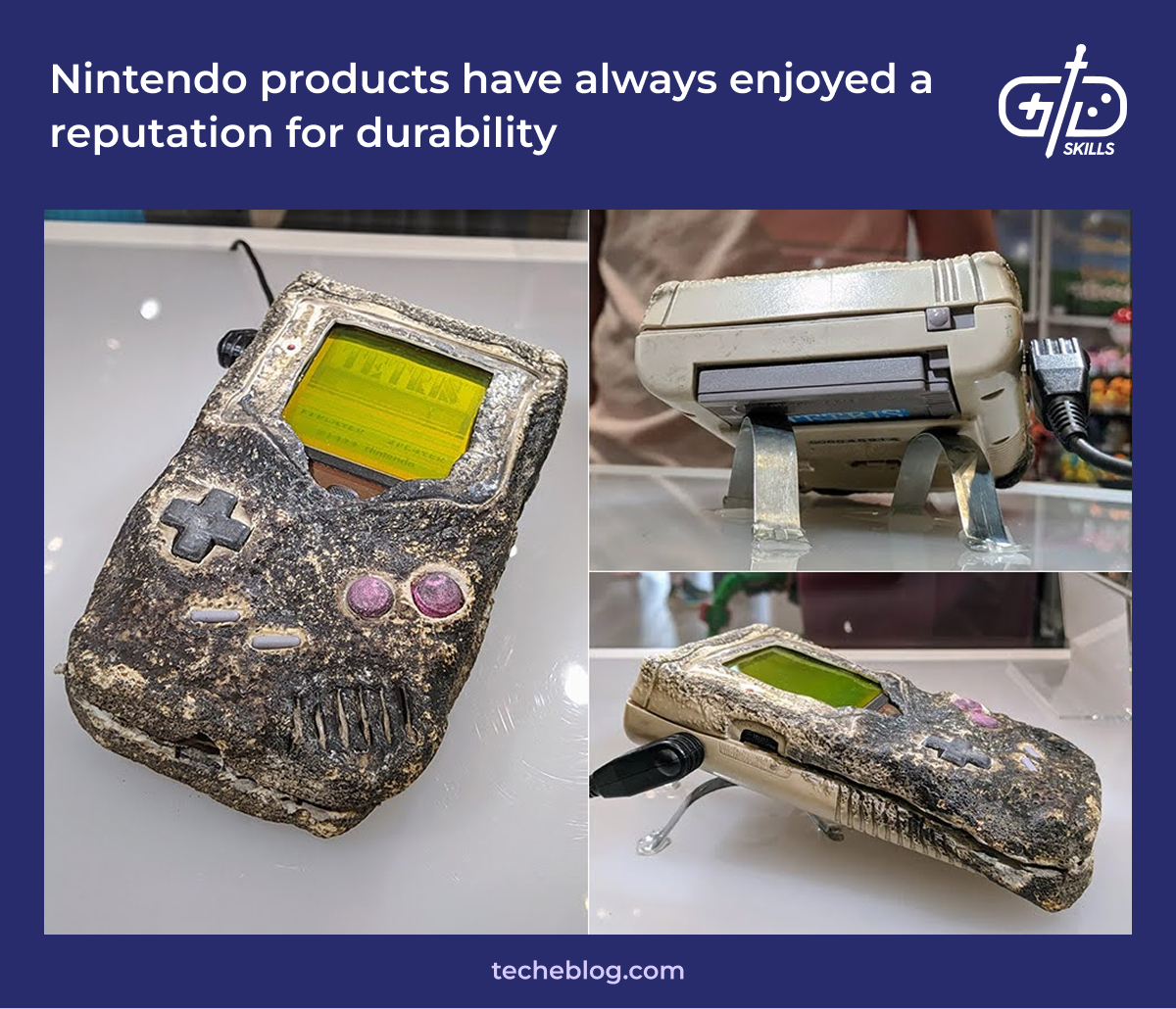
- Doom has been ported to digital pregnancy tests, ATMs, and printer displays because of its open code.
- Mario’s original name was Jumpman. It was changed to Mario after the warehouse landlord of Nintendo of America.
- After Level 29, most players can’t keep up with the speed of Tetris. Some elite players can continue using muscle memory.
- Speedrunners can complete The Legend of Zelda: The Ocarina of Time in seven minutes by exploiting a glitch.
- A developer and part-time streamer completed Sekiro: Shadows Die Twice using only a set of GameCube Donkey Kong Bongos as a controller.
- Programmer Warren Robinett created gaming’s first Easter Egg by hiding his name in-game in Adventure. Atari’s policy at the time was not to credit individual contributors.
How many video games are made each year?
Between ten thousand and fifteen thousand new games are released annually across all platforms. More than ten thousand games are released on Steam every year. Mobile games vary between one thousand and two thousand new monthly releases, but many of these are clones or minor products with little depth. About one thousand five hundred games are released on the Nintendo Switch in a typical year. Indie platforms like itch.io release thousands of titles each year, many of them only playable on PC or a browser. An exact figure is difficult to come by, but between ten and fifteen thousand commercial releases is a safe estimate.
What is the most popular video game ever?
GTA V is the most popular video game ever, if we base our ranking on which game has made the most money. Minecraft has sold the most copies of any video game, with 300 million units sold across all platforms. Minecraft hosts one hundred million monthly active players. Tetris has been enduringly popular since its release and has sold over 100 million copies across many platforms and console generations. Other honorable mentions go to games like Wii Sports, which was bundled with the Wii and saw huge crossover success with casual audiences, selling over 80 million copies. Mario Kart 8 Deluxe, another marquee Nintendo product, has gone on to be the most popular racing game in history, selling over 60 million copies. PUBG’s place at the front of the 2010s battle royale shooter pile meant it went on to sell over 75 million copies.


